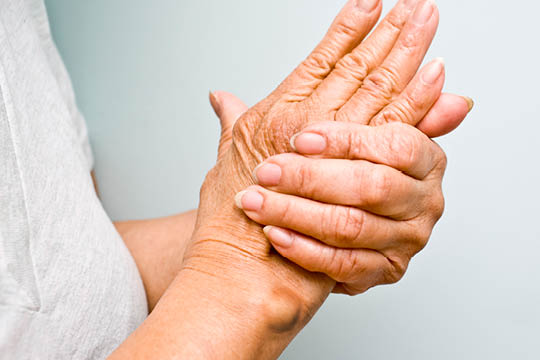A ganglion is a lump on the back of your wrist. Ganglions are cysts (collections of fluid) that vary in size and firmness. They may be soft and squishy, but sometimes feel hard like a bone. Very small ganglions that are difficult to see can be the most painful because of the level of fluid pressure inside the cyst. Some ganglions, even very large ones, can be completely pain-free.
--Tell me more about ganglions
Ganglions involve the joint fluid in the wrist bulging (outpouching) from inside the wrist, or sometimes from the sheath around a tendon. They are completely safe and harmless, though the pain can be distressing and may limit your activity.
The ganglion will be more obvious when you bend your wrist forward, and it may be difficult to fully lean on your wrist (doing a push-up, for example), because the ganglion gets squashed in this position.
Ganglions tend to come and go according to how much activity is undertaken, although they can be quite unpredictable.
--What causes ganglions?
There are a few different theories about what causes ganglions to form. A ganglion may develop after an injury or trauma to a joint or ligament in your hand. It may also form due to repetitive use of your hand, fingers or wrists. Finally, ganglions may also form due to a bulging out (herniation) of the joint capsules that surround each of the joints in your hand.
People in certain occupations—for example, guitarists, violinists and hairdressers—have a greater chance of forming a ganglion due to sustained forward wrist positions.
Many ganglions are described as ‘idiopathic’, which means that no obvious cause can be identified.
--How do I know if I have a ganglion?
Ganglions may appear suddenly or they may develop gradually over time. They usually look like a lump on the back of your wrist. Ganglions tend to fluctuate up and down in size over time, and may also change depending on your activity.
The lump will become more prominent when your wrist is flexed forward.
You can confirm the diagnosis of a wrist ganglion by getting an ultrasound, although this is rarely necessary. A doctor, physiotherapist or hand therapist will normally be able to give you a diagnosis after an examination in the clinic.
--How can physiotherapy help with ganglions?
In many cases ganglions do not require any treatment, and approximately half will resolve over time without intervention. If a ganglion is not causing pain or limiting the use of your hand, then no treatment is required. However, if a ganglion is causing pain, limiting the use of your wrist or hand, or causing compression of a nearby nerve (which may cause altered sensation, numbness or pins and needles), treatment is recommended.
The treatment that’s needed could be:
Splinting
A wrist splint may help to reduce the pain of a ganglion.
Strapping techniques
Properly applied strapping tape can often enable you to continue a higher level of loading activity (at the gym, for example) without provoking the ganglion. Your physiotherapist can show you how to strap your wrist correctly.
Activity modification
You can reduce the symptoms of a ganglion by modifying your activities and understanding what wrist positions to avoid.
Exercise
A gentle home exercise program to maintain the range of movement and function in your hand is recommended. A carefully graduated exercise program can, in some cases, desensitise the ganglion and enable the wrist to return to more normal, pain-free activity levels.
In a small percentage of people with wrist ganglions, steroid injection, aspiration (needle drainage) or surgery is required. Following the surgical removal of a ganglion, you will need physiotherapy or hand therapy for splinting, tendon gliding and careful advice about returning to normal activities.
--How effective is physiotherapy for ganglions?
Physiotherapy treatment is useful to reduce pain, improve function and educate patients about their wrist ganglion.
Patients with ongoing pain or limited function may choose to have an injection or aspiration (drainage) of their ganglion, or even opt for surgery. Studies have shown a 60 per cent recurrence rate following aspiration of ganglions. Surgical removal of ganglions is considered the most effective treatment if non-surgical treatment has failed, though there is also a risk of recurrence with surgery (approximately 16 per cent).
Physiotherapy treatment is important following surgery in order to minimise the risk of post-operative complications such as recurrence, stiffness and scarring.
--What can I do at home?
The most important thing you can do at home is simply avoid the movements or activities that aggravate your pain or discomfort. Remind and reassure yourself that your wrist is safe, and that the pain does not indicate anything dangerous or sinister in your wrist.
Movements to avoid include leaning on your wrist, bearing weight through your wrist (eg, pushing up from a chair), bending your wrist all the way forward (flexion) and holding your wrist in the forward position for longer periods of time.
You can wear a wrist splint to relieve some of the pain associated with your ganglion.
--How long until I feel better?
Ganglions come and go, so your symptoms may be short-lived and then occasionally reappear. Approximately half of all wrist ganglions will get better without treatment within a couple of years. For painful ganglions, a supportive splint will give immediate relief.
Following surgical removal of a ganglion, physiotherapy or hand therapy will normally be needed for 6–8 weeks to ensure you regain your full range of movement, strength and functional use of your hand, as well as to prevent the ganglion from recurring.

